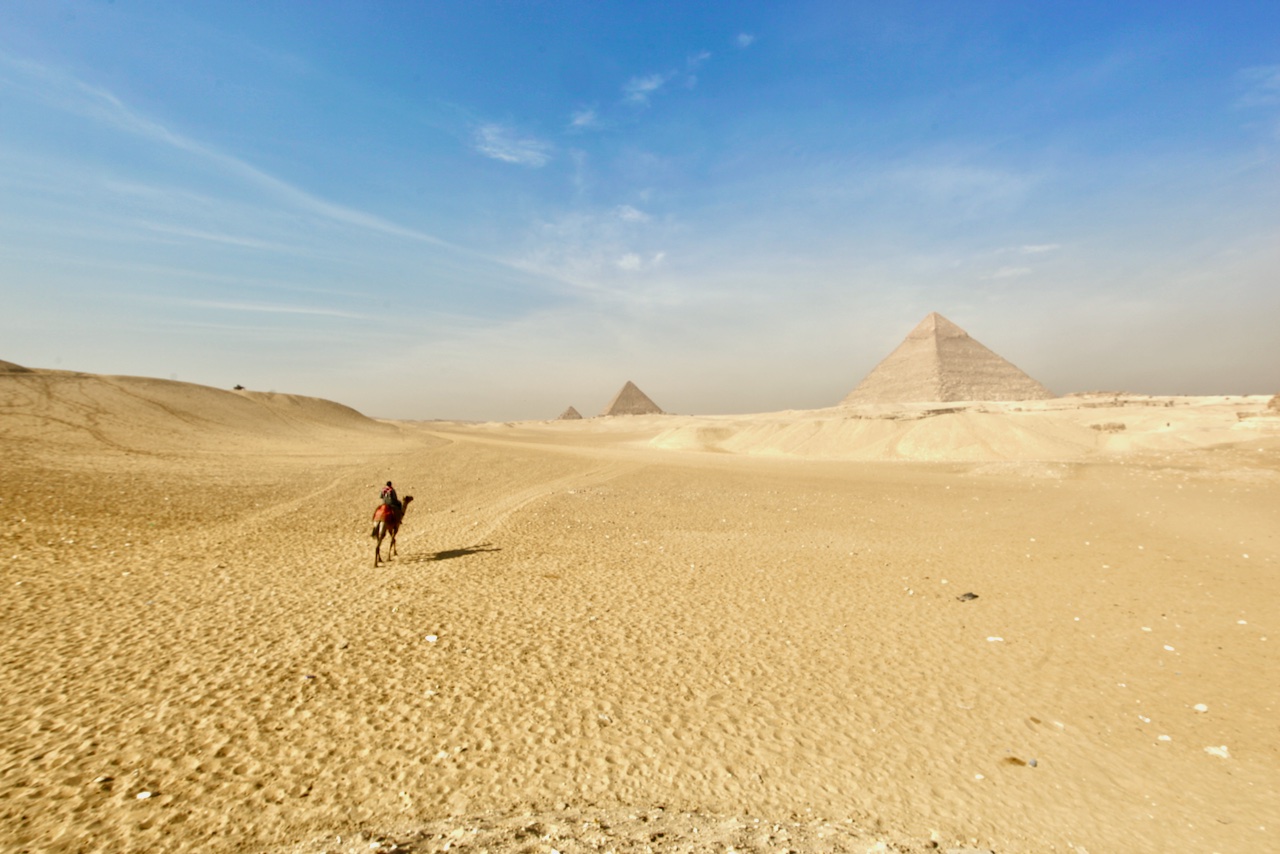Visiting the Pyramids in Egypt has long been on my travel list. On a day off from a training in Cairo, our Jordanian friend accompanied us to the Giza Plateau. He graciously took care of all the negotiations for us, which was very handy. Soon the four of us were riding towards the Pyramids on two camels and two horses.
Note: from April 2025, entrance is now through a new gate, which is further from the pyramids. This is where the Visitor Centre is located. Here are the bathrooms, rest areas, and exhibitions. You can purchase tickets at the gate via automatic machines or from the counter. From here, visitors board a bus to get to the different landmarks. Read about the changes.

I was on a mommy horse who was preoccupied with her foal who ran ahead of us and darted off here and there. Basically I had no control and the guide had to double back to check on me and to lead my horse back to the group. Eventually the guide decided to switch me onto another horse. While this new one had no foal to keep an eye on, his gaze was further afield, to the horses that to me looked like little blips. Needless to say, it was an adventure.
As one of the top destinations, the Great Pyramids and the Giza Plateau are normally busy with tour groups. I know many people who regularly lead spiritual pilgrimages there. When my friends and I visited, a Russian airbus had just been brought down over the Sinai Peninsula in Egypt. Tourism shut down and people cancelled plans. So we rode over a rather empty plateau and could quickly enter the different places.
☞ Get an eSim card for your trip in Egypt. Use my code “SUMMER20” for 20% off until September 30, 2025.





The Pyramids
The three major pyramids on the Giza Plateau are Khufu, Khafre and Menkaure, constructed in that order about 5,000 years ago. Khufu’s pyramid is what we call the “Great Pyramid” which is much bigger than the Menkaure pyramid. Each one has smaller structures known as queen’s pyramids. According to some reading, the southeast tips of these three pyramids align.
We’ve come quite a long way in our understanding of pyramids since I was in elementary school. I’d say it’s been a meander as it feels like they seem even less certain as exploration and underground scanning continue. Air shafts, burial chambers, etc. The usual who, how, why, and when still remaining outstanding. Like others, I was surprised by just how large the limestone blocks were.
More and more evidence around the world also begs the question of the timeline of history and technological advance we’ve been given. There is so much information and conflicting claims that it’s hard to discern from surface investigation of these discrepancies. For me, I was merely interested in visiting the plateau, feeling the energy of the place, going inside some of the internal structures, and hanging out with my new friends. And trying not to fall off my horse, especially while taking photographs.







Visiting the Giza complex takes several hours and as most tour groups get there mid-morning, I suggest going early morning, also for cooler weather. We were in Cairo at the end of November, a cooler time of the year, so that helped with being outside the whole time. Be sure to bring your camera. I chose a horse as in my experience it’s easier to take photos on horseback than a moving camel.

We didn’t ride up to the Sphinx, though we did see it in the distance.
What I was really glad for was our Jordanian friend. Even though the locals could easily pick off his accent, he at least made sure we got a good bargain and was taken care of. At one point, he got off his horse and the three of us had no idea what was going on. It turned out it was going to cost us more to be led back to the starting point. Our friend wasn’t having any of it. We thought perhaps it was the sudden downturn of tourism that led to such desperate and unkind tactics.
☞ Here are some Giza Plateau guided tours to check out
This would definitely not deter me from returning for another tour of the Giza Plateau and to see the Sphinx more closely.
